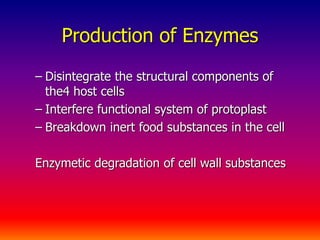How attack pathogens
- 1. Mechanisms of pathogen attacks on plants • By • H.M.N.M.Watagodakumbura • Senior Lecturer in Agriculture
- 2. Mechanisms of pathogen attacks on plants • Mainly two kinds 1. Mechanical forces on host tissue 2. Chemical weapons of pathogens
- 3. 1.Mechanical forces on host tissue Eg. Some fungi and nematodes 1. Only some fungi {Producing appresorium and penetration peg} a) After germination, germination tube make a bulb like structure is called appresorium. b) Appresorium increases area of attach to the plant. at the end of the appresorium, penetration peg is produced. c) Water is absorbed into the appresorium.
- 4. d) Then due to turgor pressure in the appresorium physical penetration by infection peg is happened. e) And also penetration is easy due to pre- softening by enzymatic secretions. 2. Nematodes- By using stylet make mechanical forces to penetrate into cells.
- 5. 2. Chemical weapons of pathogens • Allmost all pathogens except virus and viroids produce- 1. Enzymes 2. Toxins 3. Growth regulators 4. Polysaccharides
- 6. • Viruses and viroids are not producing any substances themselves. But, They induce the host cell to produce needed substances like enzymes etc.
- 7. Production of Enzymes – Disintegrate the structural components of the4 host cells – Interfere functional system of protoplast – Breakdown inert food substances in the cell Enzymetic degradation of cell wall substances
- 9. • Aerial plant part or cell wall surface consist mainly cuticle and cellulose layer. • Root cell wall consist only cellulose layer. • Cell wall consist of - cutin -wax -protein and lignin -cellulose -pectin • If pathogen attack the plants, they should digest above substances. • They are using various kinds of enzymes for this.
- 10. 1. Chitinases Eg. Many fungi and bacteria • It can digest cutin. • Enzyme reaches its highest concentration in the germ tube and infection peg in appresorium forming fungi. • Fungi that enter into host by passively, there are no any need of chitinases. • Virulent pathogen produce more chitinases
- 11. 2.Pectinases • Break down pectin chain at random sites. • Occur soft rotting of tissues. Because the middle lamella contains pectin.
- 12. 3. Cellulases Softening and disintegration of cell wall material 4. Ligninases • Breakdown lignin of cell wall, mostly those in the xylem. • Some microbes have ability to breakdown wood causing wood decay. • Brown- rot fungi degrade lignin but, they cannot utilize it • How ever, most of lignin is degraded and utilize by white- rot fungi • Some bacteria degrade lignin by causing soft rot cavities.
- 13. 5.Other enzymes • By proteases produced by pathogens,can digest proteins. • Most pathogens depends on starch with the use of amylases. • Some pathogens degrade lipids by using lipases.
- 14. 2. Production of Growth regulators • Most importantgrowth regulators are • Auxins • Gibberalines • Cytokinines • They make abnormal growth such as- Stunting Overgrowth Rossetting Excessive root branching Stem malformation Defoliation Suppression of bud growth.
- 15. 1. Auxins • IAA- cell elongation and differentiation • It increases respiration of plant tissues • It promotes the synthesis of enzymes of structural proteins. • Eg. Fungi causing corn smut Root knot nematode Bacterial crown gall Club root
- 16. 2.Gibberalines • Eg foolish seedling disease of rice • It increases plant height 3. Cytokinine • Occur chorosis, leaf abscission • Stimulation of adventious roots • Premature fruit ripening
- 17. 4. Polysaccharides • Fungi, bacteria, nematodes and some others release mucilaginous substances • Large polysaccharides molecules released by the pathogen in the xylem cause mechanical blockage of vascular bundles initiating wilting in plants.























